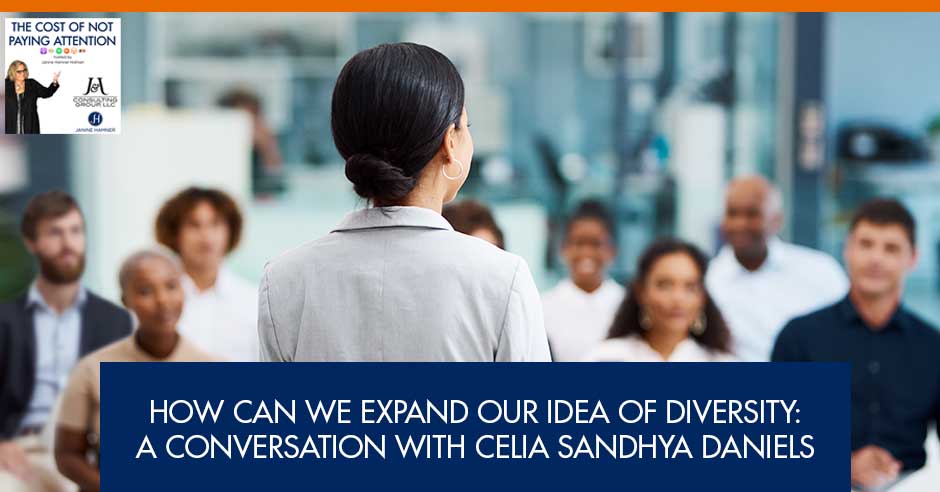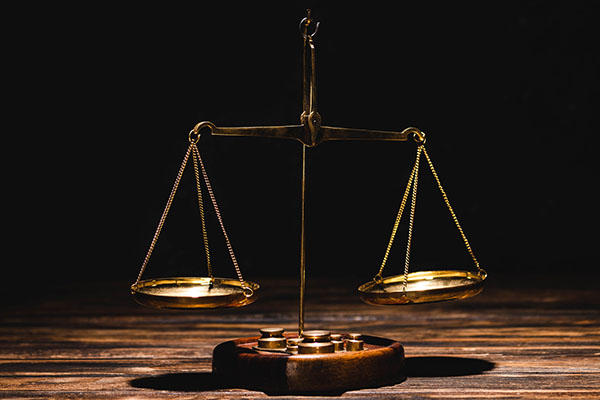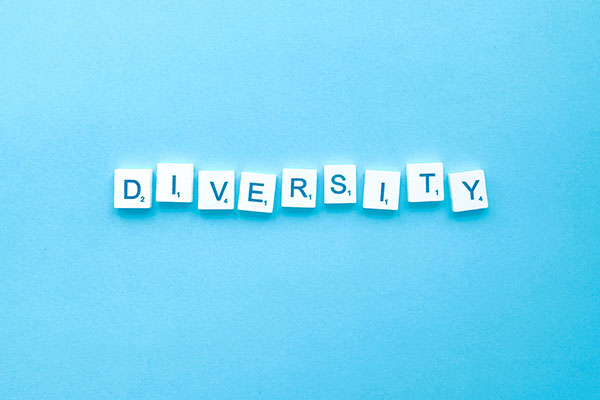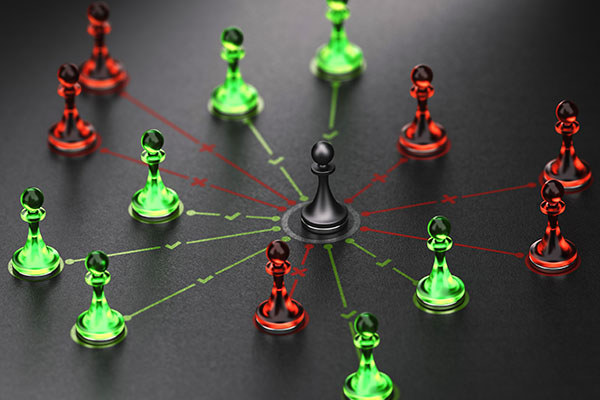
How do you incorporate diversity and inclusion in your organization without tokenizing or trivializing it? Join host Janine Hamner Holman for a fascinating and stimulating conversation on diversity with Celia Sandhya Daniels. Celia is a corporate advocate for transgender rights and a consultant with more than 20 years of demonstrated success in managing, growing, and spearheading strategic initiatives for Fortune 100 companies in technology, media, healthcare, and life sciences. She is an Asian-Indian transgender woman so she is familiar with discrimination and inequality and believes that it is not being addressed completely in many workplaces. Listen to this episode and expand your idea of diversity!
GUEST: Celia Sandhya Daniels| LinkedIn |
HOST: Janine Hamner Holman | [email protected] | LinkedIn, Facebook, and Instagram | Book me to Speak! Subscribe to my Newsletter!
—
Listen to the podcast here
How Can We Expand Our Idea Of Diversity: A Conversation With Celia Sandhya Daniels
What am I paying attention to? It’s the power of real conversations. What do I mean by a real conversation? Is there a real conversation and a fake conversation? No, but there’s a real conversation that is authentic where you get to talk about things that matter, and then there are all the superficial conversations about the weather, how your kids are doing, and maybe some day to day challenges.
When we get to have authentic conversations where we have an opportunity to go deep and to reveal parts of ourselves that matter, and we get to know somebody else at that level, it creates an immediate bond. I had that experience with my guest for this episode. Her name is Celia Daniels. I am thrilled that she’s one of my friends. I know that she’s one of my friends even though we’ve only had one conversation, but it was a real conversation.
I want to tell you a little bit about Celia. She has many years of demonstrated success in managing, growing, and spearheading initiatives for Fortune 100 companies in technology, media, healthcare, and life sciences. She has been consistently recognized for customer satisfaction, delivering innovative projects, and for leading and overseeing multiple projects and global teams both on-site and off-shore.
Here’s the other thing that’s important for you to know about Celia. She is also an Asian-Indian trans woman of color who is an entrepreneur, public speaker, activist, motivator, musician, artist, photographer, and filmmaker. She grew up as a lonely closeted kid from Southern India dealing with stigma, discrimination, and gender dysphoria. She writes and speaks passionately about her struggles and the challenges that she has faced in her family, work, school, and community, both in the US and in India.
—
Welcome to the show, Celia.
Thank you, Janine. That’s a lot of introduction.
I feel like it is important that people both get a sense that you are a highly talented accomplished woman who also happens to be Asian-Indian and trans. You’ve created an enormous amount of allyship and leadership. You’ve taken a lot of heat for it and you’ve had some setbacks around it so I want to paint a full picture of both your accomplishments and who you are in order to clearly set the stage for our conversation.

Diversity: Those difficult conversations happening in companies where you are moving the needle from where you are today and accepting that inclusivity includes all kinds of people should really be happening.
Thank you so much for that introduction.
You’re welcome. I’m going to start the way that I often start, which is by asking what is something that you have become aware of that people are not paying attention to and what’s the cost of that inattention?
A lot of times, companies talk about diversity, inclusion, belonging, equity, and equality. Many times, these are podium conversations, diversity summits, and large conferences across the globe that talk about every wonderful thing, but what they miss out on is the basic civil rights issue of the people. The one movie that I can relate to is Hidden Figures.
As a trans person, it hit me so hard when I saw that movie. When they had to go to the bathroom, they had to run to another block and then come back to their office. For me, it was exactly the same experience. As trans people, we are all talking about things that are so important, but diversity and inclusion conversations need to start from the bathroom all the way up to the boardroom. We need to have education and representation of trans folks.
My focus in the trans community is on how do you educate the allies and the companies to understand the basic needs of a human being working in your own office and have these discussions about gender-neutral bathrooms or inclusive conversations? I have not seen that. It’s always about, “We love the LGBTQ community.” They’re putting their all into that and saying, “You’re all a part of the community. Let’s talk about same-sex marriage.” I’m like, “We will talk about same-sex marriage, but I want to pee right now. Where can I go that’s safe?” They’re like, “I don’t know. You can use the women’s bathroom if you want because you’re dressed like a woman.” That is not inclusion. That is called tolerance.
I would love to see those difficult conversations happening in companies where you are moving the needle from where you are and accepting that inclusivity includes all kinds of people. I’m not just dealing with trans issues. I’m an immigrant. I’m an Asian and a parent. I have neurodiverse challenges. There are so many things in my life that I don’t see being talked about. Celia is trans and that’s about it. I would love to hear those conversations where we bring in more difficult ideas and decisions.
I saw that when I joined a company. I went through the interview process. I believe in fairness and equality even in the interview process. I want them to select me based on my intelligence, knowledge, professional experience, and my background, and it happened. They loved everything that I brought to the table as a trans person. I loved it. The process was very good. I was consulting for a company, and they were trying to bring me on board.
Diversity and inclusion needs to start from the bathroom all the way up to the boardroom. Click To Tweet
During the onboarding, they said, “We have a security issue.” I asked them, “What kind of security issue?” They said, “We don’t know how to onboard you.” I was like, “You’re a company that has incorporated equality. You have all pride flags flying all over during the month of June. You have a good ERG for LGBTQ and good transgender policies, but why can’t you onboard me?” They replied, “We are not able to onboard you.”
The problem I found out later was they didn’t know how to onboard me because they didn’t have the policies in place to onboard a person after they transitioned from the previous gender. It was not easy for them. I told them it is as simple as a person being single and a person getting married and changing the name, but here, the issue was a little more complicated because I came in as a gender X.
They didn’t know where to place me, and they tried to fit it somewhere. They said, “We figured it out.” I said, “That’s fine. What about the next issue?” They responded, “We don’t know how to open up your records when you had worked in the past as Daniel and how we are going to manage this, the trainings, and all the security protocols we follow.” I said, “I want to start fresh. Go and figure it out.”
Sometimes, companies love hiring trans people. It’s tokenism where they love hiring trans people, but they don’t know how to retain trans people. You love hiring trans folks. You love to do trainings, panels, discussions, and all the wonderful stuff, but you don’t know how to do the process and the organizational changes in terms of the people, processes, and the technology that acts up gender non-binary. They were never taught about all that.
I sat and explained because I worked in different IT companies. I’ve done strategy for IT and also businesses. I said, “Let’s look at the people, process, and technology and start changing it.” I gave them a whole idea. I showed them all the ways in which they could do it, but I said, “I’m not going to do it. You need to do it. I’ve been advocating for myself for the past couple of years. I don’t want to do it. I cannot be educating you again when you think you have been advancing in your diversity spectrum.”
I even recommended that we can change the policies and I can help them with that, but what I’ve seen, most of the time, is companies love talking about things that are at the surface level. As long as you don’t bring in paid challenges, don’t talk about titles, psychological safety, or promotions. Their attitude is, “Don’t talk about this, but we love diversity.” Diversity without an E in your diversity strategy itself doesn’t make any sense to me.
They may be a great pony that you can show around like, “Look at this pretty pony that we hired,” but that’s not the point. I don’t want to be a pretty pony. You don’t want to be a pretty pony. What we want to be building are organizations in which people know that they are welcomed, included, and they belong because it’s good for the organization and for the individual. We feel great when we belong.

Diversity: You should always believe in fairness and equality, even in the interview process. You want to be selected based on your intelligence, knowledge, professional experience and background.
By our neurobiology, human beings are herd animals. We want to be together. When we feel like we belong someplace, we then become loyal to that organization. We’re going to stick around. We’re going to do outstanding work. Here we are at the height, probably, of the Great Resignation, and organizations are still missing the point. We can’ talk about diversity as though it’s one thing or all we need to do is tell HR, “We need to get some people who are Brown, Black, Asian, neurodiverse, and gender fluid,” if we haven’t done the work ahead of time to consider, “What is it going to be like for that person when they come to this organization?”
Inclusion should not cause exclusion. That’s something that I’ve seen. It’s causing exclusion. I value companies. Let’s put it that way. I sometimes bring up all these points because we need to have honest conversations. That’s one thing. Even if I’m working for certain companies and my clients, I always tell them with grace, “Here’s a problem. Here’s how we can fix it.”
I don’t just say, “This is a problem.” That’s not helpful because they may not have a context. So, I keep telling them about it. I always give them a solution, a way to fix the problem. That’s what I’ve learned in my many years of working as a consultant. You don’t go to them and tell them, “You have a problem.” You need to know how to fix it.
We should probably even talk about how do you feel when everyone is included in diversity and inclusion. It’s not just the minority, people with neurodiverse challenges, women, or LGBTQ, but even folks who are supportive of this initiative. How do you bring that equality with a good representation or a good support for diversity initiatives? I would love to talk about that also because that is important for companies to consider.
I had the great honor of being one of the keynote speakers for the US Navy’s first summit on diversity. I was in this building, and all of the restrooms were non-gendered restrooms. They were all stalls. You went into the restroom and then into your little stall, did your business, and then came out and washed your hands.
I was in my stall and then next to me was a guy. Next to him was another guy, and then there was a woman. We were all in the bathroom together. When I first walked in, I thought, “What’s happening here?” We can allow ourselves to be in situations where we feel a little bit uncomfortable for a minute, and then we can get over it.
I came out of the stall and washed my hands. I then had a chat with the guy who had been in the stall next to me. Here we were at this three-day conference for the US Navy, an organization that I do not necessarily think of as having it all together around diversity, and they had non-gender assigned restrooms where everybody went. I thought it was a teeny little symbol of something beginning to shift.
Inclusion should not cause an exclusion. Click To Tweet
I love that you talked about inclusion having to be done from the bathroom to the boardroom because, on the one hand, it’s little. On the other hand, it’s not. It’s important. It is both small and, at the same time, an important symbol of beginning to think differently about how we can create spaces in which everybody belongs. I say, “Who cares? As long as I’m in my little stall, I don’t care if there’s a guy in his little stall next to me.”
There’s a commercial on TV. The tagline is, “We all go, so why not enjoy the go?” It’s for toilet tissue. Part of what I love about it is that it’s taking that, “That’s something that we don’t talk about.” We all go. It is a human biological function. If we haven’t thought about how we’re going to include people in those simple human biological functions, that is an easy place to start. If the US Navy can do it, anybody can do it.
My hope is that a CEO or other executive will read this and think, “I do care about this. I do want to think about the ways that we can ensure that everyone: men, women, transgender people, gay, straight, and all the different races and ethnicities – White people, Black people, Brown people, Yellow people, Purple people – can feel that they belong. Where are the places that people can start looking?”
It’s important for you to think about the intersectional identity of a human being or your employee. I have a friend who is White and lost his wife to cancer. He’s having a hard time getting along, coming to the office and managing things at work, keeping his sanity, and trying to pretend like nothing is wrong with him, but he is going through a lot emotionally.
When companies talk about minorities and having so many other issues, they are probably excluding some of those conversations. To me, I would look at diversity mostly in terms of ethnicities, not just checking boxes of Black, Brown, Latinx, or another community, but rather looking at the whole intersectional way of addressing the issues in a human being.
The first question I would ask is, “Tell me what would help you to thrive in the workplace. What would help you to be creative and innovative that you feel like you want to wake up and come to the office in the morning?” This person would say, “I have this issue.” As a trans person, I love coming to the office. My barrier is not about the bathrooms and the other issues. Those are discussions that are important but my barrier could be getting misgendered when I come to the office place, so I want to make sure that I don’t feel misgendered.
When I’m on a phone call, they stop me and ask, “Am I talking to Celia?” I reply, “I’m Celia.” They then comment, “You sound like a man.” To which, I respond, “I’m transgender.” I don’t want to keep reminding people that I’m transgender. The point is when you bring your whole self to work, you are bringing a lot of things that can change the way in which the framework of the company can be better. You bring in the emotional point of being open to saying, “I don’t feel good today. I want to take off from work,” or, “I feel excited. Something happened, and I’m happy about it.”

Diversity: Diversity is looking at the whole intersectional way of addressing the issues in a human being.
Sharing your failures and your emotions in a workplace and feeling psychologically safe is what everyone talks about. Psychological safety is across the board for everybody. That is paramount in terms of addressing your mental and physical health. When you address that, the rest of the other issues probably will fall in place.
I’ll give you an example of why I mentioned the bathroom. A lot of times, people talk about trans folks using pronouns. They get all flustered saying, “All these pronouns are hard. I don’t know why they want to be called they/them.” The issue they don’t understand is the trauma when they wake up in the morning and are supposedly living in a home where the parents keep telling them, “I don’t know how my child is going to survive in school because he came out as trans. They’re getting bullied at school.” When they go to college, they have issues in the dorm. When they go to a workplace, they don’t get recognized or promoted. They feel like these people are a stumbling block to the good performers.
When you go to the community, you’re not welcome in a church because you are a sinner. That’s how they look at it. You then go to the other issues. You get pulled over by the police. When they look at my license, they say, “You look different. In your license, you’re not transitioned, so I’m going to probably take you for further questioning.” It hasn’t happened to me, but I’ve been pulled over many times. I’ve started educating the LAPD and Hollywood PD for that reason.
When you take the whole ecosystem of the issues that trans people go through, it’s pretty intense. There are healthcare issues and school board issues. All this makes them feel ostracized in every segment and ecosystem that they are living in. It is systematically challenged that way. All they’re asking us is, “I don’t feel like I belong to the binary world. I feel like I’m in a spectrum, and I want to be called as they.”
In a space where I feel more comfortable in someone’s space, I am Celia, and I go by their pronouns. I feel comfortable and psychologically safe that they’re able to acknowledge that. When you don’t do that, what happens is even the companies say, “I’m not going to call you by this one. I’m going to call you whatever I think I want to call you,” and then what you feel is you’re going through trauma in every day when you’re waking up.
I’ll give a simple example. My middle name is Sandhya. It’s a Sanskrit name. When I was talking to some folks, and I said, “My name is Celia Sandhya Daniels,” they asked, “What is Sandhya?” I responded, “Sandhya is a Sanskrit name for dusk. It’s beautiful. It’s evening time.” So then they said, “I can’t spell that. Can I call you Sandy?” I said, “No. That shows that you are not respecting who I am, my ethnicity, my culture, and my value. You’re throwing something at me. Who the heck is Sandy? What does Sandy even mean to me?” Those are the kind of conversations we need to bring into the workplace, saying, “Respect the person the way they want to be respected.”
Unfortunately, 48% of Americans do not want to use pronouns and have gender-neutral language in the workplace because they feel like that’s too much on them. They feel like, “These people have chosen a lifestyle. Why am I adhering to it? It’s not my problem. Do you want to be called they/them? You can go and ask someone to do it. I’m not going to call you that.” That’s the attitude they have. The only reason I ask them that is to respect us for the simple little thing that we asked because we’ve gone through the root cause issues of all that is causing us to have these traumas every day. They don’t understand.
When you're faced with uncomfortable situations, you always learn from them. Click To Tweet
I could be sitting at a happy hour with my colleagues in Texas, and the restaurant owner comes to me and says, “Can you please leave? We don’t sell to people like you.” It can happen, and that’s the kind of situation we are facing. Is they/them such a difficult thing to use to respect or value a person? That’s why I speak up. I tell them, “That is the simplest thing on Earth.”
I have a friend. Her name was Xing Xing. I called her and I said, “I know your name is Xing Xing, but I want to know the right way to pronounce it. In China, how do they say it?” She told me the right way to pronounce that. I wrote it down on my iPhone and also in my meeting notes so that whenever I addressed her, I was saying her name the right way. For me, even the little things matter. I could see that she was smiling. She said, “You don’t have to take so much effort to learn my name. It’s okay.” I said, “I do.” That’s not inclusion. Inclusion is not trying to change your name to get included somewhere. Inclusion is bringing your authentic self so that people will call you the way it should be done.
My husband’s name is Jonathan. It’s important that people address him as Jonathan and not John, Johnny, or Jack. Jonathan is a very common American name, and it’s also important to him that people spell it right. Our names are important to us. What you did by making the effort to say her name correctly is to have her feel like she truly belongs and you’re acknowledging who she is with the right pronunciation of her name. These are both beautiful.
It is an easy thing for us to acknowledge. We can say, “Your name is unique to me. I’ve never heard your name before. I want to make sure that I pronounce it correctly. Can you please help me understand how to pronounce it correctly so that I get it right and I honor who you are?” I am hopeful that the same thing will happen with pronouns although, unfortunately, it may be some years down the road.
I have a good friend whose daughter is a lesbian. I don’t think she’s transgender. I haven’t seen her in quite a while, so I’m not 100% sure, but I know that she goes by the pronouns they/them. I was having a conversation with her mom, my friend, Annie, about her daughter, who has also changed her name. I had think consciously about pronouns.
A friend of mine who is a White woman is doing some work with organizations around diversity, as am I. She told me that people always say to her that it’s uncomfortable or it’s hard. It may be a little uncomfortable and hard. It may take a bit of getting used to, but so what?
I tell my clients who are ready to hear it, “It’s our turn to be a little uncomfortable.” This is an important idea for those of us who have had the privilege of going through life in the United States in a White body, Lots of people have felt uncomfortable in their Black body, Brown body, non-binary body, neuro-diverse body, or disabled body. As we’re looking to create a world in which everyone belongs, then some of us who have not yet been uncomfortable, maybe it is our turn.
You brought up a great point because when you’re faced with uncomfortable situations, you always learn from those situations. You don’t walk away from it, you learn something. Nothing comes out of a comfortable conversation. You can always casually talk because everyone around you is watchful. You’re walking with eyes watching you. They’re saying, “Let’s be careful. You don’t want to touch anything.”

Diversity: When you take the whole ecosystem of the issues that trans people go through, and it’s pretty intense healthcare and school board issues, it makes them feel ostracized.
When I think about diversity and inclusion, it’s more like, “All of you can come to the party, but don’t sit on that couch.” They could also be like, “You’re trans? There is a bathroom for you outside. Bring soda. Don’t do this. Don’t keep it on the table.” There are things that you can do when you invite people. To me, when you’re inviting or hiring trans folks or anybody with ethnic minority, it feels like you’re saying, “We only have a few life jackets here. If there is something that happens, you’re on your own.” That is what I always care about.
I do all these panel discussions and keynote speaking. When a company asks me to be their speaker, I ask them, “Do you have any policies for trans folks?” They say, “We don’t.” I then tell them, “I’m going to speak in your company, but I can also take a look at your policy and help you so that if you call me or if you call any trans person to be talking in this panel next year, we can see some progress.”
We want to have tangible action items when we talk about diversity. Let’s have some metrics. Let’s measure where we are and see how we can move the needle. A lot of companies are uncomfortable with that. They’re like, “We love diversity conversations. We have hired this person and this director.” I say, “What are you folks doing?” They answer, “We are still teaching people, learning, and listening.” I comment, “You are in the stone age. You got to be out there. Times are changing.”
Twenty-seven percent of the youth in California identify as gender non-binary. This statistic was from the Williams Institute from UCLA in 2019. Think about it. It’s 2022. The numbers have probably gone up. Seventy-five percent of the workforce in 2025 are going to be Millennials and Gen Zs. They care about the value of the company. They don’t care about titles or moving up in the company. They care about working for a company that is valued, where they’re respected, and they feel like they belong to that company. That’s why it’s so important to take a look at our future generation. When you plan your diversity programs and your inclusion programs, always think about the future. That’s the way you can sustain these programs for a while. Make it long-term and stretch it out.
I tell some companies that I’ve been working with, “You’re so established in the US. Have you thought about your subsidiaries across the world?” They say, “We have, and they do their own thing.” I’m tell them, “That’s not how it should be. You need to talk to those employees working in Dubai, the Middle East, India, Europe, Africa, or any other countries and ask what kind of diversity programs they have. Do a cross-exchange. Learn from it. Understand the nuances of that because they have different kinds of issues. There could be tribal indigenous issues in certain places which you can learn from.” That’s how these initiatives are lifelong. It may not put down anyone to be implemented, but it should be elevated to make everyone feel included. That’s the way we can implement this in the long-term.
Our opportunity is to stop seeing the power and belonging as a zero-sum game which is like, “If you have more power and more belonging, then I have less.” We should grow the pie bigger so that we all belong, have a voice, and have equity. We are all invested in the work of the organization. I was doing a presentation to a group of CEOs and I was talking about what is the biggest reason that people in the Great Resignation are not retiring, not getting fired, but quitting their jobs. The biggest single reason is organizations are not paying enough attention to diversity, equity, and inclusion.
The CEO said, “How old were the people who were being interviewed? Were these all Millennials?” I said what you said. “The reality is that in a couple of years, 75% of the workforce is going to be Millennials. I don’t care whether you are in line with what they think. They are the majority. Even the Gen Zs who are coming after them care more about issues around diversity, equity, inclusion.” This is a business imperative. This is no longer, “It’s nice to be able to say we have a transgender person. We get to show that person off.” If you want your organization to continue to exist and be profitable, you must get a handle on this.
This has been another wonderful conversation with you. I am so honored to have you here with us to share your wisdom and your enormous experience. You’re challenging us to be on the growth edge and to not settle for conversations that are easy where we don’t grow but to be willing to have the hard conversations when we do grow and when great things can happen for ourselves and our organizations. Thank you so much for being here with us.
I would like to end with one thought for the audience, which would be easy for them to remember. It’s called ALLIES. Be an amazing ally.
- A is to Acknowledge your privilege.
- L is to Listen to the community.
- Another L is to Learn to unlearn.
- I is to Initiate tough and uncomfortable conversations.
- E is to Educate yourself and educate others.
- S is to be Supportive by being involved.
If you’re looking for a way to be a powerful ally for any community, this is something that you need to remember.
That’s a beautiful last thought. That’s the end of the show. Remember, great leaders make great teams. Until next time.
Important Links
About Celia Sandhya Daniels
 I have over 20+ years of demonstrated success in managing, growing, and spearheading strategic initiatives for fortune 100 companies in Technology, Media, Healthcare, and Life sciences. I have been consistently recognized for customer satisfaction and delivering innovative projects, leading and overseeing multiple projects and global teams both onsite/offshore. I have the ability to understand and align with the business goals and quickly develop innovative, sell ideas through presentations for tough, demanding customers has proven to be her greatest assets.
I have over 20+ years of demonstrated success in managing, growing, and spearheading strategic initiatives for fortune 100 companies in Technology, Media, Healthcare, and Life sciences. I have been consistently recognized for customer satisfaction and delivering innovative projects, leading and overseeing multiple projects and global teams both onsite/offshore. I have the ability to understand and align with the business goals and quickly develop innovative, sell ideas through presentations for tough, demanding customers has proven to be her greatest assets.
I am an Asian Indian trans woman of color who is an entrepreneur, public speaker, activist, motivator, musician, artist, photographer, and filmmaker. Growing up as a lonely closeted kid from Southern India with stigma, discrimination, and gender dysphoria, I write and speak passionately about the struggles and challenges I faced in my family, work, school, and community both in US and India.
As a management consultant with top fortune 500 companies, I educate, empower, and advocate for transgender and gender non-binary individuals in the corporate world. I have built allyship with local businesses, police dept, therapists, doctors, churches, and civil rights organizations in US and India to educate them about bullying, transgender violence, discrimination, healthcare policies, and employment.





